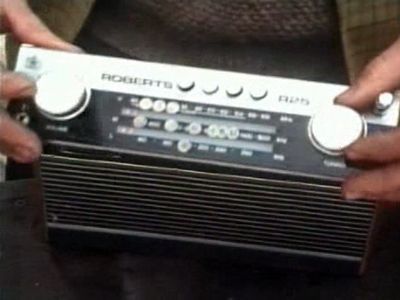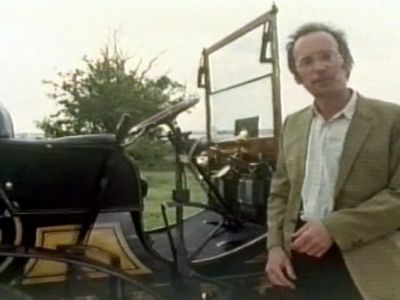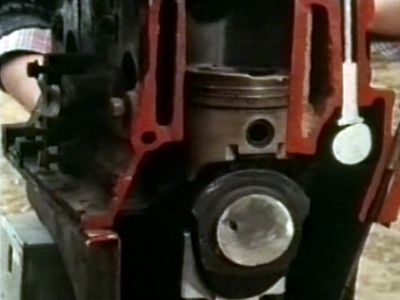The BEST episodes of The Secret Life of Machines season 2
Every episode of The Secret Life of Machines season 2, ranked from best to worst by thousands of votes from fans of the show. The best episodes of The Secret Life of Machines season 2!
Tim Hunkin explains how the machines we use every day actually work, using a fascinating combination of experiments, analogies, animation, and larger-than-lifesize working models. The TV series was the outgrowth of a series of cartoons for the Observer newspaper called "The Rudiments of Wisdom", which Tim researched and drew for 14 years. The theme music is a version of Dave Brubeck's "Take Five" by Val Bennett, retitled "The Russians are Coming".

#1 - The Radio
Season 2 - Episode 5 - Aired 2/5/1991
Any electrical spark creates radio waves and acts as a transmitter. You hear sparks on a radio as interference. That's why lighting makes radios crackle, and even the tiny spark in a switch is enough to make a noise on the radio when turning on a light. Episode Contents: Models: Toilet tube crystal set. Machines: Lovely little (1 metre long) RC car made by Rex for kids show. Guests: A Hertz induction coil and loop reciever. Early Marconi radios. Antique BBC transmitter (c.1920) and it's modern equivalent. Various antique sets and accessories. Films: The cartoon life of young Marconi and an old Armstrong. An ad for 1950 plastic RCA portables. Extro: Motorized novelty radios.

#2 - The Motor Car
Season 2 - Episode 1 - Aired 1/8/1991
Cars started to become popular in the 1890s. Their success was partly due to the bicycle, which had given people a taste for a personal means of transport. It was also due to Daimler's high speed engine, the first internal combustion engine to be small enough not to make a vehicle ridiculously cumbersome. Episode Contents: Models: A gutted modern body shell. A running car stripped down to the chassis. An exposed brake glows as it's applied. Machines: A mini that drives away from itself! Guests: A penny farthing and other antique bicycles. A 1902 Woolsey. Films: The cartoon life Daimler und Benz. Some quaint english promo films for early cars and lots of assembly line footage. A late 40's ad for a "FUTURAMIC" oldsmobile. A 60's advert for an Austin mini. Citroen promo film showing the toughness of the bodyshell design. Extro: Crushing defeat.

#3 - The Internal Combustion Engine
Season 2 - Episode 2 - Aired 1/15/1991
The first internal combustion engine was made by a Frenchman called Etienne Lenoir in 1859. He simply modified a steam engine to suck in and ignite the inflammable gas from his gas lights. Unfortunately the explosions were very violent and the engine was very inefficient. Episode Contents: Models: A gasoline powered lager can mortar. A cutaway model shows the fundamental features of the engine: piston, valves, etc. Machines: An odd little vehicle with a hydraulic life made for a tv show. Guests: A tiny model airplane engine shows amazing power/size ratio. A Hornsby Ackroyd (c.1895) engine runs on parafin. Films: 40's promotional clips for car culture... Cartoon lives of Otto and Diesel. Extro: Motor mad disciples carry an offering to Carhenge!

#4 - The Quartz Watch
Season 2 - Episode 3 - Aired 1/22/1991
All clocks and watches work by 'counting' some event which takes a fixed period of time, like the swings of a pendulum. The higher it goes the stronger the pull of gravity and the faster it comes back - so the swings always take a fixed time. The Quartz crystal in a watch vibrates at a fixed speed in a similar way. Episode Contents: Models: A stick. Demonstration of liquid crystal technology with metal coated glass plates and polarized sunglasses. Machines: Many of Tim's large outdoor clocks. A water clock by Rex. Guests: A 400 year old pendulum alarm clock. Various antique pocket watches. Different watch models track the evolution of quartz and digital watches. Films: Goofy 1940's wristwatch commercial ("Hey kids come on a running!") Almost as silly 70's ad for the first bulky LED watch. Extro: Oven door blooper and a melting digital watch.

#5 - The Telephone
Season 2 - Episode 4 - Aired 1/29/1991
The forerunner of the telephone was the telegraph. By 1870 all major towns in Europe and America had telegraphs, sending messages in 'on' and 'off' pulses (e.g. Morse code). It was while trying to improve the telegraph that Bell discovered the telephone. Episode Contents: Models: A tiny telephone system (less power supply!). A speaker using solenoid coil, magnet and base drum. A homemade microphone of plastic lid and carbon particles Machines: A cheeky store automaton that induces rabid commercialism. An acoustic probe by Rex. Guests: Several old telegraph machines using odd protocols. A 60s era mechanical "click and bang" telephone exchange (they are fun to watch). A funky 30's era burglar alarm complete with telephone dialer and a message for the police on the phonograph. Films: The cartoon life of that famous scot/canuck Alexander Graham Bell. An all singing all dancing Bell film promoting a phone every five feet. Extro: Stop motion phones.

#6 - The Video Recorder
Season 2 - Episode 6 - Aired 2/12/1991
The principle of magnetic recording was invented by a Danish telephone engineer called Valdemar Poulsen in 1899. He used an electromagnet to record the tiny electric currents from a telephone to magnetise a steel wire. This recreated tiny currents in the electromagnet when it was replayed. All tape and video recorders still work this way. Episode Contents: Models: A band saw magnetic recorder. Recording a signal on scotch tape covered in rust (FeO^2) particles. A large model of a VCR type head and it's concentrative powers. Illustration of helical scanning. Machines: Great intro scene by Tim and Rex (e.g. slanting cupboards, man eating garbage disposal, rabid mailman, dogfood eating kid, and the oblivious housewife). Rubber band powered beavers. Guests: An early Paulson wire tape recorder. A really impressive German "tapedeck" (c.1930) that used razor sharp steel bands running at high speed under high tension. An airplane black box. A 1940's German tape machine the Tonstreiber (sp?). Ampex VTR's at the BBC. A range of major domestic video formats. Films: The earliest video recordings. A dramatic illustration of generational loss in VHS (re)recordings. Sad adult cartoon characters trying to program their VCR. Extro: Very odd living room scene with mechanically animated knick knacks, spinning stools, tippy stereo components etc.